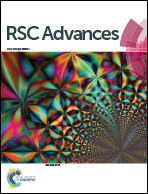Degradation of atrazine from the riparian zone with a PEC system based on an anode of N–S–TiO2 nanocrystal-modified TiO2 nanotubes and an activated carbon photocathode
Abstract
In this study, we developed a photoelectrochemical (PEC) system based on an anode of N–S–TiO2 nanocrystal-modified TiO2 nanotubes and an activated carbon photocathode to degrade atrazine from the riparian zone. This material of N–S–TiO2/AC was characterized by SEM, XRD, XPS, EDX and fluorescence detection. The characterization results indicated that the systems of NS–TiO2–TiO2/AC and NS–TiO2 NCs/TNTAs-AC/PTFE allowed the highest yield of ˙OH. According to the simulation results of the absorbance of N–S–TiO2 with MS, N–S–TiO2 has a maximum absorbance at 155 nm and 237 nm in the UV region; the average absorbance of N–S–TiO2 in the visible region was 10 000 higher than that of TiO2. At pH 5.9, N–S–TiO2 NCs/TiO2 NTs-AC/PTFE realized the highest atrazine removal rate, reaching a 93.89% atrazine removal rate within 150 min in water from the riparian buffer zone. The PEC system comprising the anode of N–S–TiO2 nanocrystal-modified TiO2 nanotubes and the activated carbon photocathode might be an efficient way to remove atrazine in the riparian buffer zone.


 Please wait while we load your content...
Please wait while we load your content...